Pathogenicity of Phytophthora× alni Isolates Obtained from Symptomatic Trees, Soil and Water against Alder
Abstract
1. Introduction
2. Materials and Methods
2.1. Isolates Used in the Study
2.2. Morphologic Characterization of Mycelium, Vegetative and Generative Organs and Effect of Temperature on Mycelium Growth
2.3. Laboratory Tests of Pathogenicity
2.4. Greenhouse Tests of Pathogenicity
2.5. Re-Isolation of the Pathogen
2.6. Statistical Analysis
3. Results
3.1. Morphology of Mycelium, and Vegetative and Generative Organs
3.2. Growth of Mycelium Depending on Medium and Temperature
3.3. Laboratory Tests
3.4. Greenhouse Tests
3.5. Re-Isolation of the Pathogen
3.6. PCA Analysis
4. Discussion
5. Conclusions
Supplementary Materials
Author Contributions
Funding
Institutional Review Board Statement
Informed Consent Statement
Data Availability Statement
Acknowledgments
Conflicts of Interest
References
- Streito, J.-C.; Legrand, P.; Tabary, F.; Jarnouen de Villartay, G. Phytophthora disease of alder (Alnus glutinosa) in France: Investigation between 1995 and 1999. For. Pathol. 2002, 32, 179–191. [Google Scholar] [CrossRef]
- Brasier, C.M.; Rose, J.; Gibbs, J.N. An unusual Phytophthora associated with widespread alder mortality in Britain. Plant Pathol. 1995, 44, 999–1007. [Google Scholar] [CrossRef]
- Brasier, C.M.; Cooke, D.E.L.; Duncan, J.M. Origin of a new Phytophthora pathogen through interspecific hybridization. Proc. Natl. Acad. Sci. USA 1999, 96, 5878–5883. [Google Scholar] [CrossRef] [PubMed]
- Gibbs, J.N.; Lipscombe, M.A.; Peace, A.J. The impact of Phytophthora disease on riparian populations of common alder (Alnus glutinosa) in southern Britain. Eur. J. For. Pathol. 1999, 29, 39–50. [Google Scholar] [CrossRef]
- Streito, J.-C.; Gibbs, J.N. Alder Phytophthora in France and the United Kingdom: Symptoms, isolation methods, distribution, and damage. In Phytophtora Diseases of Forest Trees, Corvallis, Oregon, USA, 30.08–03.09.1999; Hansen, E.M., Sutton, W., Eds.; Oregon State University: Corvallis, OR, USA, 2000; pp. 37–39. [Google Scholar]
- Gibbs, J.N. Phytophthora root disease of alder in Britain. Bull. OEPP/EPPO Bull. 1995, 25, 661–664. [Google Scholar] [CrossRef]
- Jung, T.; Blaschke, M. Phytophthora root and collar rot alders in Bavaria: Distribution, modes of spread and possible management strategies. Plant Pathol. 2004, 53, 197–208. [Google Scholar] [CrossRef]
- Cech, T.; Hendry, S. A review of diebacks and declines of alder (Alnus spp.) in Europe. For. Comm. Bull. 2003, 126, 15–24. [Google Scholar]
- De Gruyter, J.; Man In’t Veldt, W.A. Phytophthora disease of alder. Ann. Rep. Plant Prot. Ser. Neth. 2000, 85–94. [Google Scholar]
- Szabó, I.; Nagy, Z.; Bakonyi, J.; Érsek, T. First report of Phytophthora root and collar rot of alder in Hungary. Plant Dis. 2000, 84, 1251. [Google Scholar] [CrossRef] [PubMed]
- Webber, J.; Gibbs, J.; Hendry, S. Phytophthora Disease of Alder; Forestry Commission: Edinburgh, UK, 2004. [Google Scholar]
- Černý, K.; Gregorová, B.; Holub, V.; Strnadová, V. First finds of ‘alder Phytophthora’ in the Czech Republic. Czech Mycol. 2003, 55, 291–296. [Google Scholar] [CrossRef]
- Santini, A.; Barzanti, G.P.; Capretti, P. A new Phytophthora root disease of alder in Italy. Plant Dis. 2001, 85, 560. [Google Scholar] [CrossRef] [PubMed]
- Varela, C.P.; Martinez, C.R.; Vázquez, J.P.M.; Casal, O.A. First report of Phytophthora rot on alders caused by Phytophthora alni subsp. alni in Spain. Plant Dis. 2010, 94, 273. [Google Scholar] [CrossRef] [PubMed]
- Solla, A.; Pérez-Sierra, A.; Corcobado, T.; Haque, M.M.; Diez, J.J.; Jung, T. Phytophthora alni on Alnus glutinosa reported for the first time in Spain. Plant Pathol. 2010, 59, 798. [Google Scholar] [CrossRef]
- CABI/EPPO. Phytophthora Alni [Distribution Map]. Distribution Maps of Plant Diseases, 1st ed.; CABI: Wallingford, UK, 2008. [Google Scholar]
- Adams, G.C.; Catal, M.; Trummer, L.; Hansen, E.M.; Reeser, P.; Worrall, J.J. Phytophthora alni subsp. uniformis found in Alaska beneath thinleaf alders. Plant Health Prog. 2008, 9, 38. [Google Scholar] [CrossRef]
- Adams, G.C.; Catal, M.; Trummer, L. Distribution and severity of alder Phytophthora in Alaska. In Proceedings of the Sudden Oak Death Fourth Science Symposium, Santa Cruz, CA, USA, 15–18 June 2009. [Google Scholar]
- Sims, L.L.; Sutton, W.; Reeser, P.; Hansen, E.M. The Phytophthora species assemblage and diversity in riparian alder ecosystem of western Oregon, USA. Mycologia 2015, 107, 889–902. [Google Scholar] [CrossRef]
- Brasier, C.M.; Kirk, S.A.; Delcan, J.; Cooke, D.E.L.; Jung, T.; Man In’t Veldt, W.A. Phytophthora alni sp. nov. and its variants: Designation of emerging heteroploid hybrid pathogens spreading on Alnus trees. Mycol. Res. 2004, 108, 1172–1184. [Google Scholar] [CrossRef] [PubMed]
- Husson, C.; Aguayo, J.; Revellin, C.; Frey, P.; Ioos, R.; Marçais, B. Evidence for homoploid speciation in Phytophthora alni supports taxonomic reclassification in this species complex. Fungal Genet. Biol. 2015, 77, 12–21. [Google Scholar] [CrossRef]
- Orlikowski, L.B.; Oszako, T.; Szkuta, G. First record of alder Phytophthora in Poland. J. Plant Prot. Res. 2003, 43, 33–39. [Google Scholar]
- Oszako, T.; Orlikowski, L.B. Phytophthora alni as the main cause of the alder decline in Poland. Prog. Plant Prot. 2005, 45, 343–350. (In Polish) [Google Scholar]
- Oszako, T. The usefulness of traps and PDA medium for Phytophthora alni isolation from infected tissues and soil. Sylwan 2006, 150, 59–64. (In Polish) [Google Scholar]
- Trzewik, A.; Orlikowska, T.; Oszako, T. The threat by Phytophthora alni of alder (Alnus glutinosa) in Poland. Adv. Agric. Sci. Probl. Iss. 2008, 529, 227–233. (In Polish) [Google Scholar]
- Trzewik, A.; Orlikowski, L.B.; Oszako, T.; Nowakowska, J.A.; Orlikowska, T. The characterization of Phytophthora isolates obtained from diseased Alnus glutinosa in Poland. Balt. For. 2015, 21, 44–50. [Google Scholar]
- Oszako, T. Contribution of Phytophthora spp. in the phenomenon of alder decline in Poland. Phytopathol. Pol. 2010, 57, 53–62. [Google Scholar]
- Orlikowski, L.B.; Oszako, T.; Szkuta, G. First record of Phytophthora spp. associated with the decline of European beech stand in south-west Poland. Phytopathol. Pol. 2006, 42, 37–46. [Google Scholar]
- Orlikowski, L.B.; Trzewik, A.; Orlikowska, T. Water as potential source of Phytophthora citricola. J. Plant Prot. Res. 2007, 47, 125–132. [Google Scholar]
- Ioos, R.; Husson, C.; Andrieux, A.; Frey, P. SCAR-Based PCR primers to detect the hybrid pathogen Phytophthora alni and its subspecies causing alder disease in Europe. Eur. J. Plant Pathol. 2005, 112, 323–335. [Google Scholar] [CrossRef]
- Trzewik, A.; Orlikowska, T. Detection and identification of Phytophthora alni. Commun. Agric. Appl. Biol. Sci. Ghent Univ. 2010, 75, 655–658. [Google Scholar]
- Kannwischer, M.E.; Mitchell, D.J. The influence of a fungicide on the epidemiology of black shank of tabacco. Phytopathology 1978, 68, 1760–1765. [Google Scholar] [CrossRef]
- Jung, T.; Downing, M.; Blaschke, M.; Vernon, T. Phytophthora root and collar rot of alders caused by the invasive Phytophthora alni: Actual distribution, pathways, and modeled potential distribution in Bavaria. In Alien Invasive Species and International Trade; Evans, H., Oszako, T., Eds.; Forest Research Institute: Warsaw, Poland, 2007; pp. 10–18. [Google Scholar]
- Jung, T.; Pérez-Sierra, A.; Durán, A.; Jung, M.H.; Balci, Y.; Scanu, B. Cancer and decline diseases caused by soil- and airborne Phytophthora species in forests and woodlands. Persoonia 2018, 40, 182–220. [Google Scholar] [CrossRef]
- Stivrins, N.; Buchan, M.S.; Disbrey, H.R.; Kuosmanen, N.; Latalowa, M.; Lempinen, J.; Muukkonen, P.; Slowinski, M.; Veski, S.; Seppa, H. Widespread, episodic decline of alder (Alnus) during the medieval period in the boreal forest of Europe. J. Quat. Sci. 2017, 32, 903–907. [Google Scholar] [CrossRef]
- San Jose, M.C.; Cernadas, M.J.; Janeiro, L.V.; Blazquez, N.; Mosteiro, F.; De Anta, A.; De Castro, E.; Cuenca, B. In Vitro propagation of tolerant alders for the conservation of riverbanks. Study of their resistance to Phytophthora alni. In Perspectivas del Aqua. Investigación, Gestión, y Valores del Aqua en el Mundo Actual; Alvarez-Valasquez, M.A., De Una-Alvarez, E., Coordinatores; Dykinson: Madrid, Spain, 2019; pp. 103–110. ISBN 978-84-1324-549-2. [Google Scholar]
- Štochlová, P.; Novotná, K.; Černý, K. Variation in Alnus glutinosa susceptibility to Phytophthora × alni infection and its geographic pattern in the Czech Republic. For. Pathol. 2016, 46, 3–10. [Google Scholar] [CrossRef]
- Oszako, T. Alder decline in Poland. In Proceedings of the IUFRO Working Party Diseases and Insects in Forest Nurseries, the Sixth Meeting, Uherské Hradištĕ, Czech Republic, 11–14 September 2007; pp. 129–137. [Google Scholar]
- Bregant, C.; Sanna, G.P.; Bottos, A.; Maddau, L.; Montecchio, L.; Linaldeddu, B.T. Divesity and pathogenicity of Phytophthora species associated with declining alder trees in Italy and description of Phytophthora alpine sp. nov. Forests 2020, 11, 848. [Google Scholar] [CrossRef]
- Haque, M.M.; Martin-Garciá, J.; Diez, J.J. Variation in pathogenicity among the three subspecies of Phytophthora alni on detached leaves, twigs and branches of Alnus glutinosa. For. Pathol. 2015, 45, 484–491. [Google Scholar] [CrossRef]
- Chandelier, A.; Husson, C.; Druart, P.; Marcais, B. Assessment of inoculation methods for screening black alder resistance to Phytophthora × alni. Plant Pathol. 2016, 65, 441–450. [Google Scholar] [CrossRef]
- Štochlová, P.; Novotná, K.; Černý, K. Factors affecting the development of Phytophthora alni spp. alni infections in Alnus glutinosa L. J. For. Sci. 2012, 58, 123–130. [Google Scholar] [CrossRef]
- Zamora-Ballesteros, C.; Haque, M.M.U.; Diez, J.J.; Martin-Garcia, J. Pathogenicity of Phytophthors alni complex and P. plurivora in Alnus glutinosa seedlings. For. Pathol. 2017, 47, e12299. [Google Scholar] [CrossRef]
- Engelbrecht, J.; Duong, T.A.; Prabhu, S.A.; Seedat, M.; van den Berg, N. Genome of the destructive oomycete Phytophthora cinnamomi provides insights into its pathogenicity and adaptive potential. BMC Genomi. 2021, 22, 302. [Google Scholar] [CrossRef] [PubMed]
- De Andrade Lourenco, D.; Branco, J.; Choupina, A. Phytopathogenic oomycetes: A review focusin on Phytophthora cinnamomi and biotechnological approaches. Mol. Biol. Rep. 2020, 47, 9179–9188. [Google Scholar] [CrossRef] [PubMed]
- Eggers, J.E. Variation among Phytophthora cinnamomi isolates from oak forest soils in the Eastern United States. Plant Dis. 2012, 96, 1608–1614. [Google Scholar] [CrossRef] [PubMed][Green Version]
- Kasuga, T.; Kozanitas, M.; Bui, M.; Huberli, D.; Rizzo, D.M.; Garbelotto, M. Phenotypic diversification is associated with host-induced transposon derepression in the sudden oak death pathogen Phytophthora ramorum. PLoS ONE 2012, 7, e34728. [Google Scholar] [CrossRef]
- Linde, C.; Kemp, G.H.J.; Wingfield, M.J. Variation in pathogenicity among South African isolates of Phytophthora cinnamomi. Eur. J. Plant Pathol. 1999, 105, 231–239. [Google Scholar] [CrossRef]
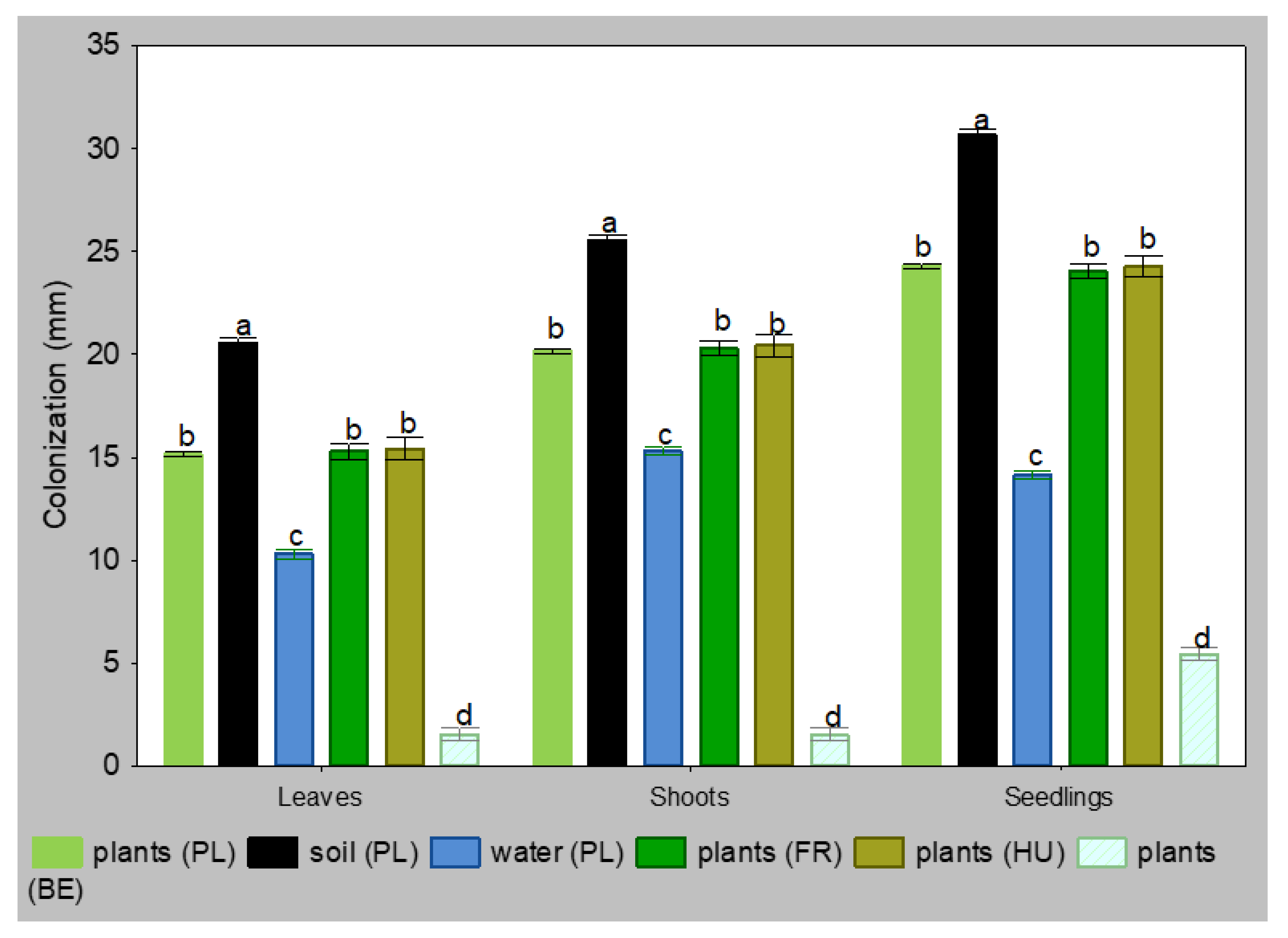
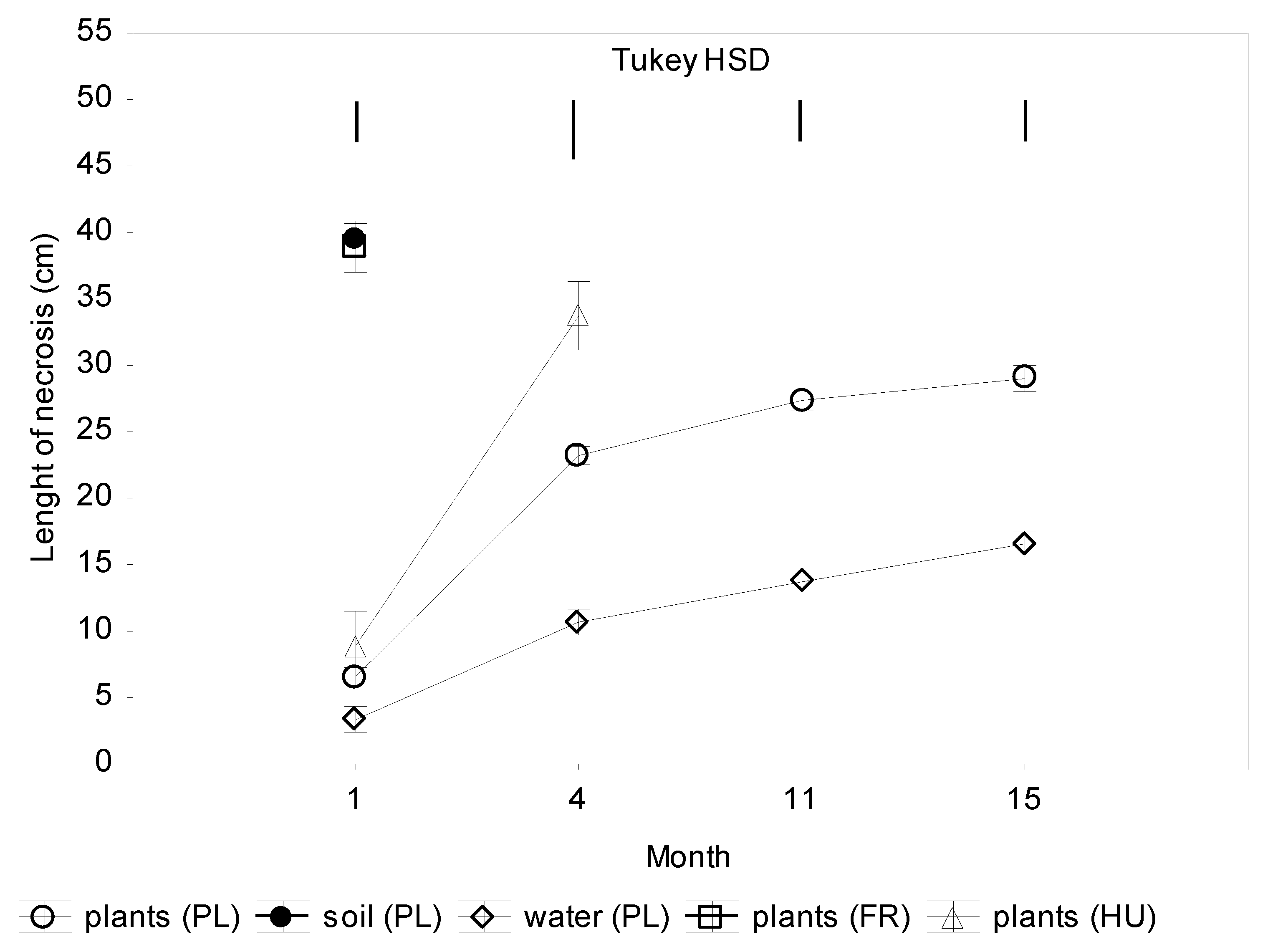
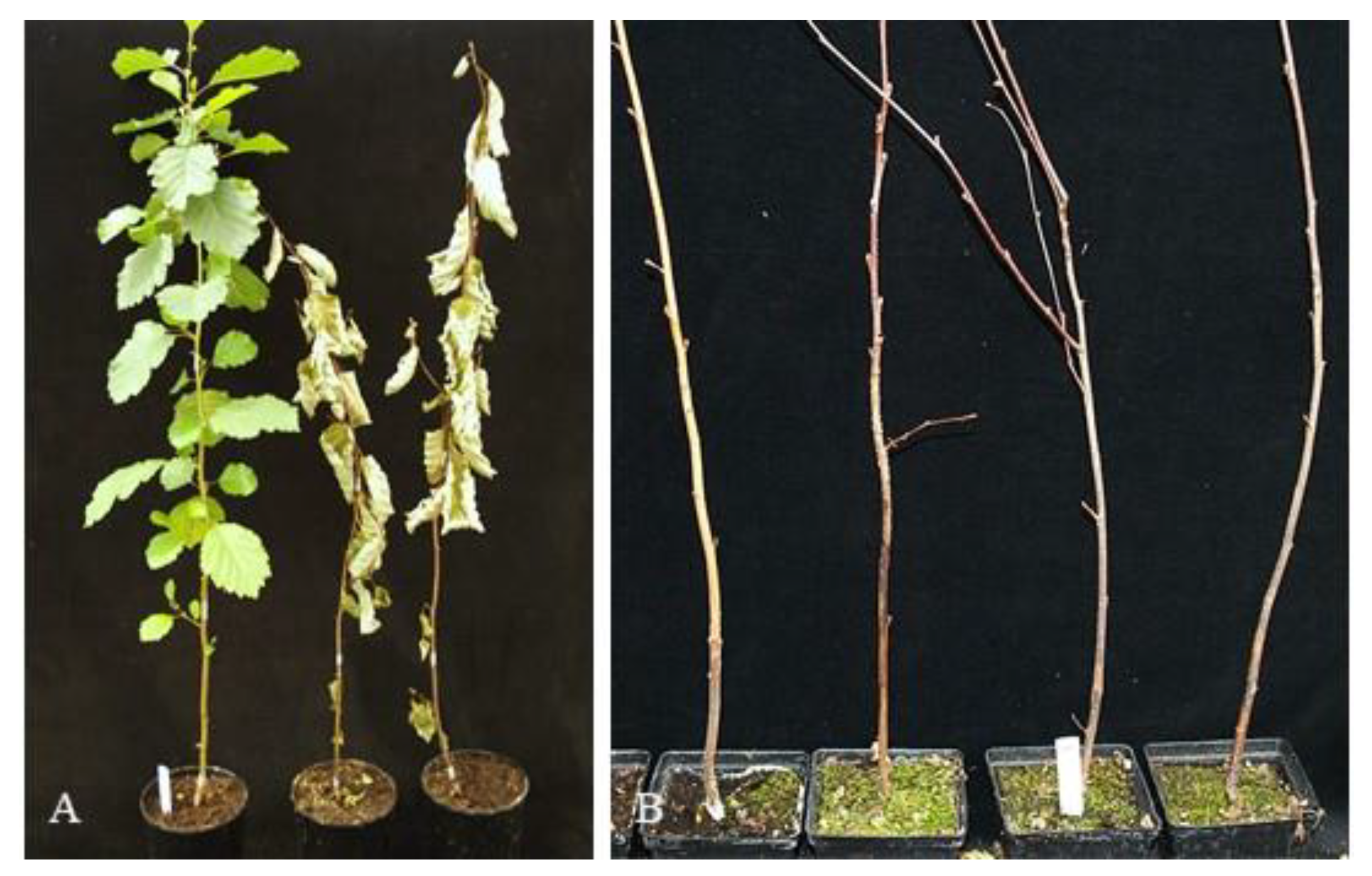
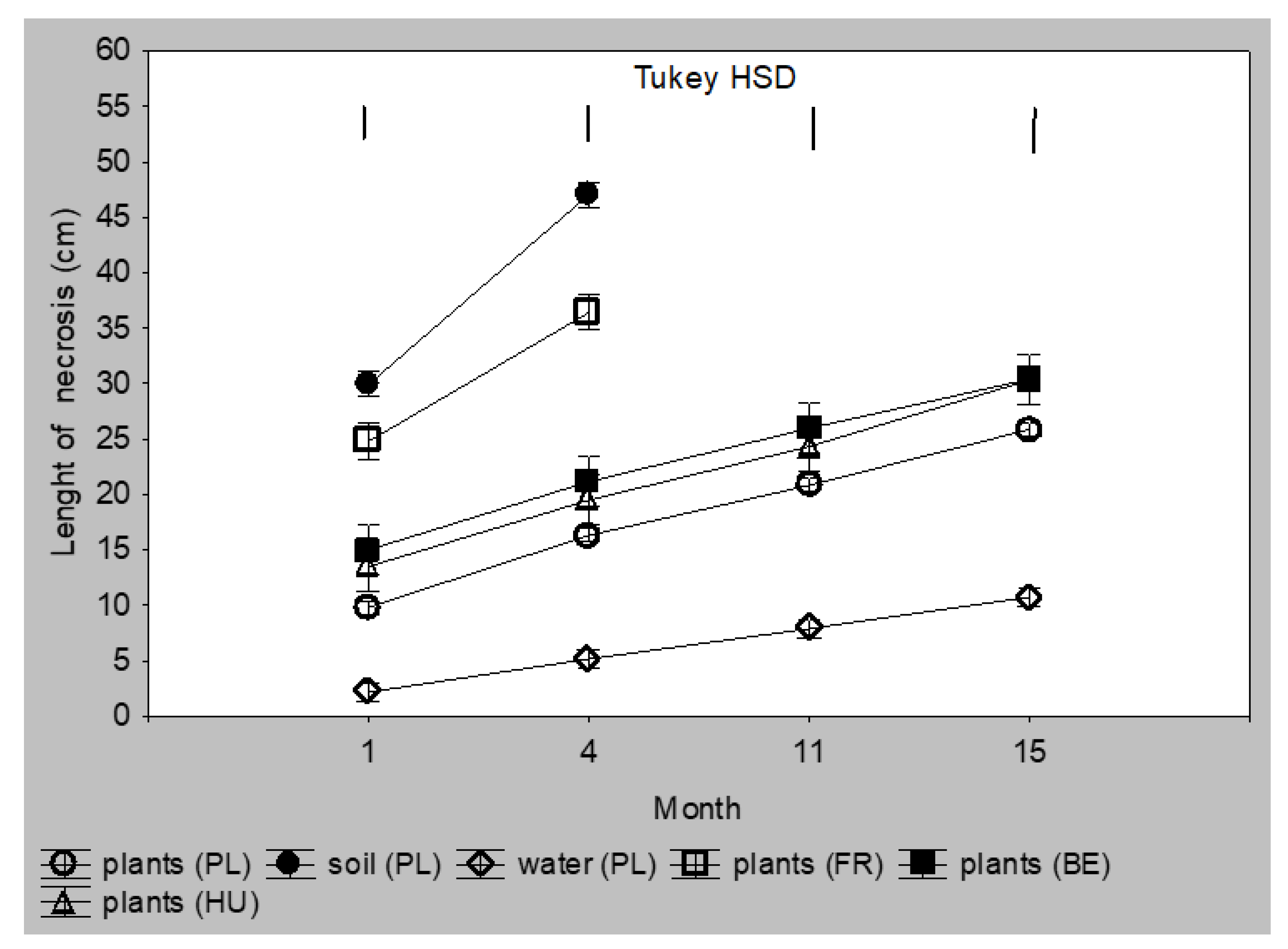
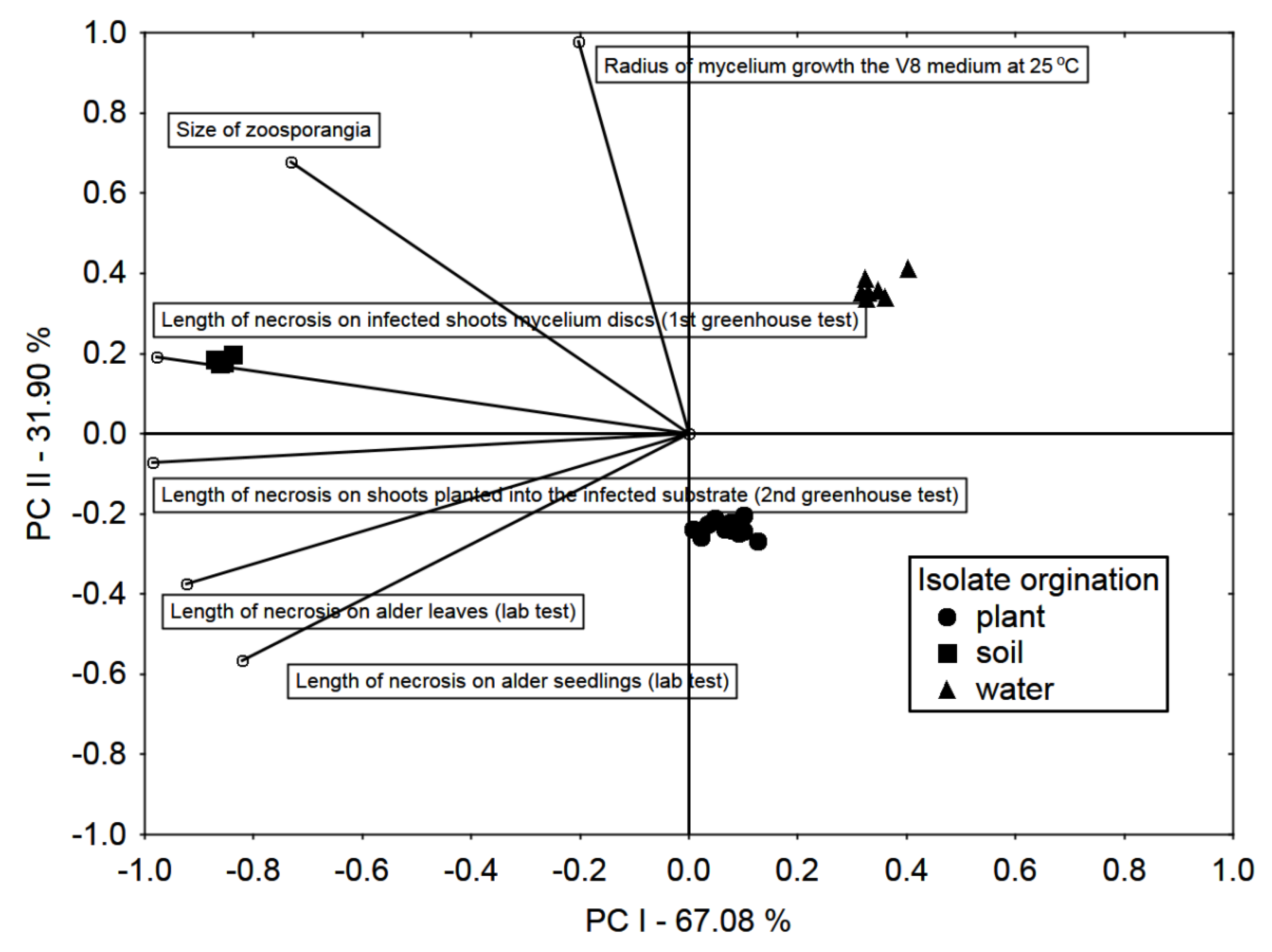
| Isolates of P. × alni (Number of Isolates Measured) | Dimensions of Zoosporangia (µm) ± SD | |
|---|---|---|
| Length | Width | |
| P. × alni obtained from alder trunks (18) | 50.4 1 c ± 7.64 | 34.2 c ± 5.1 |
| P. × alni obtained from soil (4) | 62.0 a ± 6.47 | 45.0 a ± 4.1 |
| P. × alni obtained from water (7) | 54.5 b ± 6.23 | 36.6 b ± 4.1 |
| Isolates of P. × alni (Number of Isolates Evaluated) | Daily Growth of Hyphae at 25 °C (mm/24 h) | ||
|---|---|---|---|
| PDA | V8 | CA | |
| P. × alni obtained from alder trunks (18) | 3.82 1 c ± 0.19 | 6.81 b ± 0.23 | 9.48 a ± 0.14 |
| P. × alni obtained from soil (4) | 3.86 c ± 0.20 | 9.11 a ± 0.26 | 7.11 b ± 0.26 |
| P. × alni obtained from water (7) | 3.78 c ± 0.21 | 9.14 a ± 0.32 | 7.11 b ± 0.33 |
Publisher’s Note: MDPI stays neutral with regard to jurisdictional claims in published maps and institutional affiliations. |
© 2021 by the authors. Licensee MDPI, Basel, Switzerland. This article is an open access article distributed under the terms and conditions of the Creative Commons Attribution (CC BY) license (https://creativecommons.org/licenses/by/4.0/).
Share and Cite
Trzewik, A.; Maciorowski, R.; Orlikowska, T. Pathogenicity of Phytophthora× alni Isolates Obtained from Symptomatic Trees, Soil and Water against Alder. Forests 2022, 13, 20. https://doi.org/10.3390/f13010020
Trzewik A, Maciorowski R, Orlikowska T. Pathogenicity of Phytophthora× alni Isolates Obtained from Symptomatic Trees, Soil and Water against Alder. Forests. 2022; 13(1):20. https://doi.org/10.3390/f13010020
Chicago/Turabian StyleTrzewik, Aleksandra, Robert Maciorowski, and Teresa Orlikowska. 2022. "Pathogenicity of Phytophthora× alni Isolates Obtained from Symptomatic Trees, Soil and Water against Alder" Forests 13, no. 1: 20. https://doi.org/10.3390/f13010020
APA StyleTrzewik, A., Maciorowski, R., & Orlikowska, T. (2022). Pathogenicity of Phytophthora× alni Isolates Obtained from Symptomatic Trees, Soil and Water against Alder. Forests, 13(1), 20. https://doi.org/10.3390/f13010020






